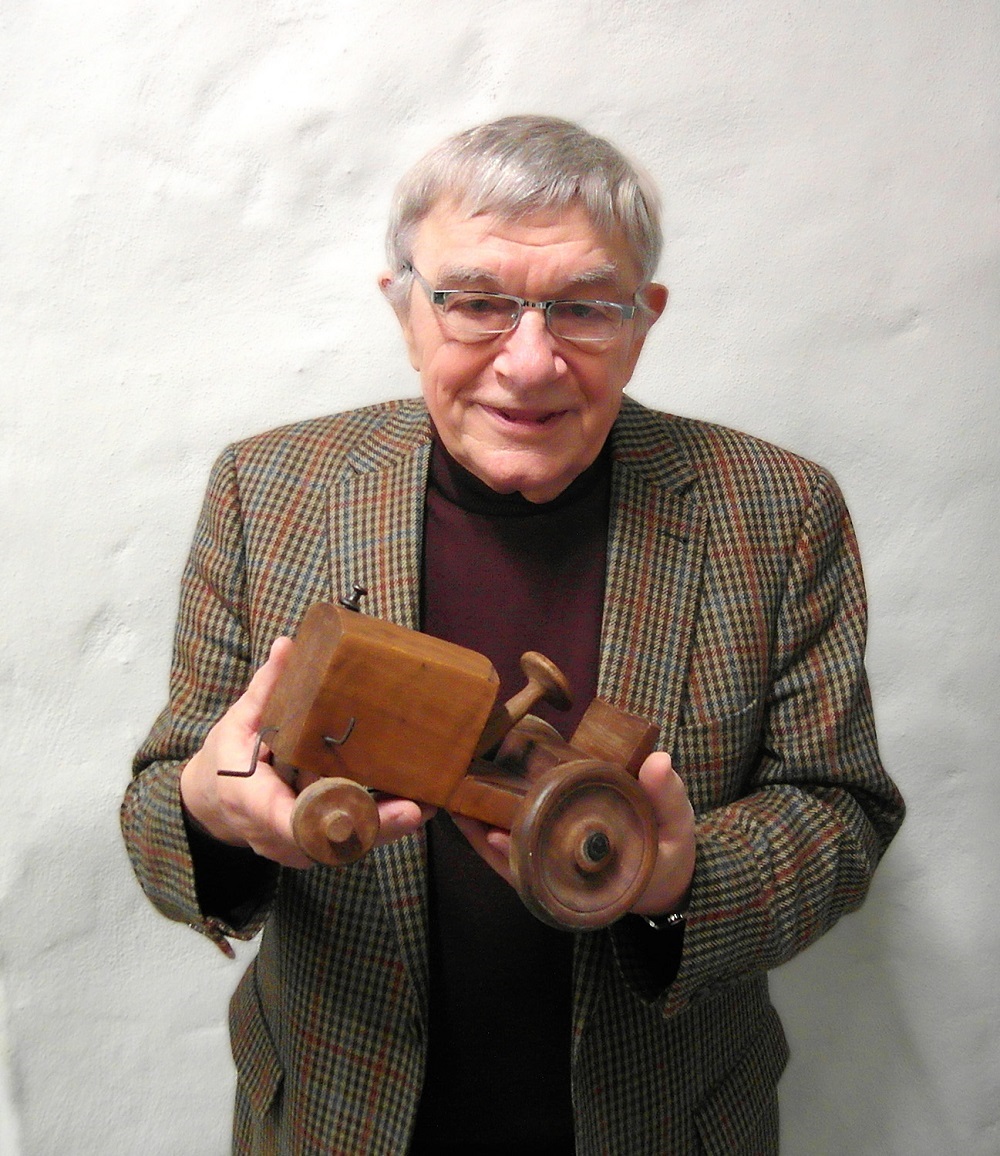"Bandwidth" - the diversity of the museum collection
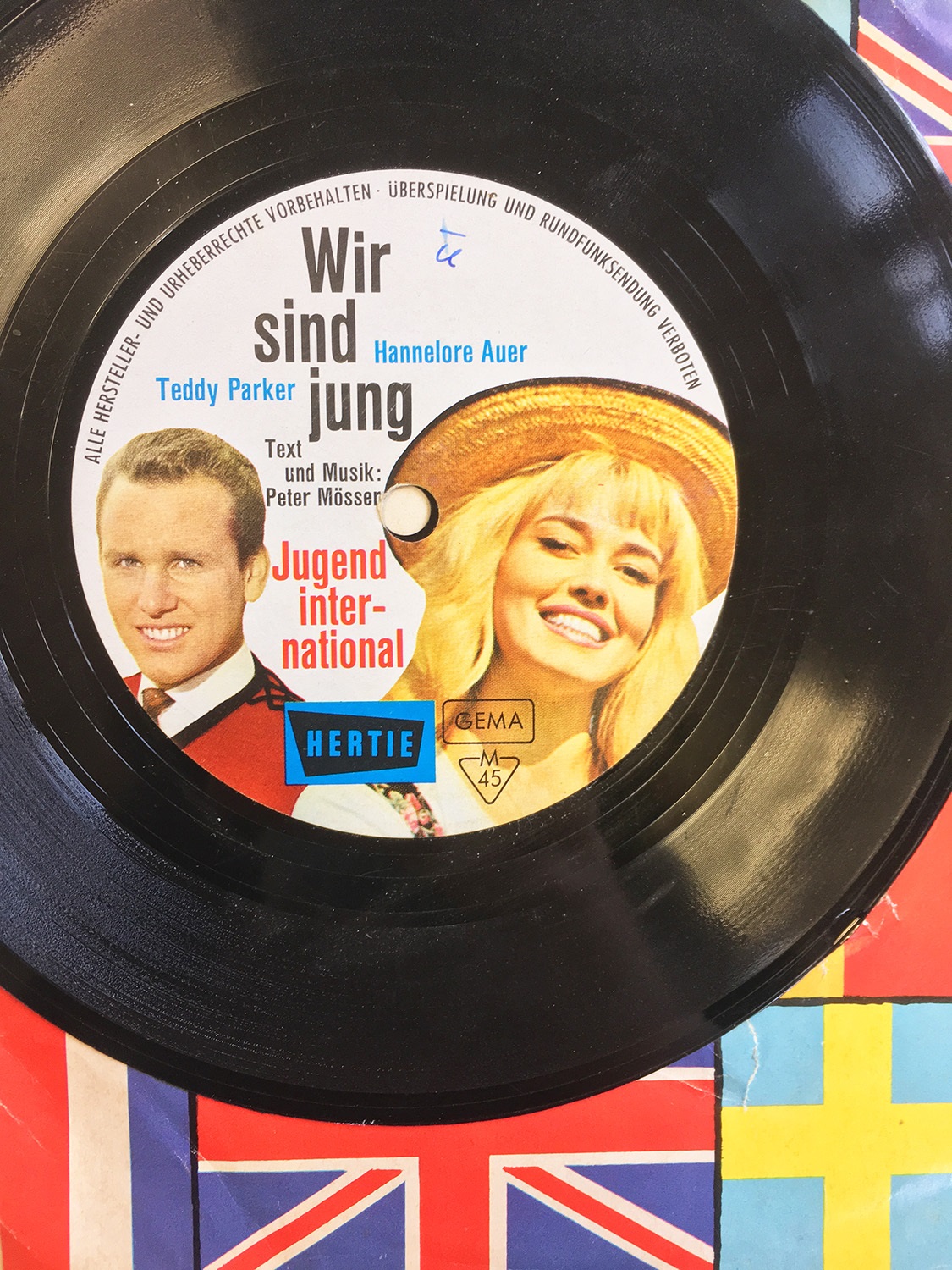
They had a normal single format, but their vinyl foil was so thin and flexible that grooves were only pressed into one side. On this copy, Hannelore Auer and Teddy Parker sang about adventurous, travel-loving and fashion-conscious young people with lots of "Yeah, Yeah!" in the chorus. At the end, they used a spoken advertising message to make the HERTIE department store appealing to the teens and twens as an inexpensive source of shopping. Once the sound foil was on the turntable, it certainly had a more intensive advertising effect than a newspaper advertisement that had been skimmed over.
At the time, the two artists were not among the top German pop singers, but had already released several singles and appeared in several music films. Both continued to make a name for themselves until the early 2000s: Claus Herwig aka Teddy Parker as a folk music singer and Hannelore Auer as Heino's wife, manager and presenting partner ("Heino und Hannelore").
The sound foil with the title "Wir sind jung" ("We are young") was part of the "Jugend International" sales show as an advertising medium, which was also referred to by the numerous national flags on the sleeve. In 1963, records, clothing and camping articles were presented in special areas for young customers in many HERTIE stores. In Wolfsburg, there was even a postcard showing the Hertie department store with a large "Jugend-International" banner on the façade. The new department store was opened here in November 1960 and provided a metropolitan shopping flair in the Volkswagen city for many years. The record department on the 2nd floor was an important point of contact for music lovers.
The Hertie department store was closed in summer 2003 and largely demolished. Today, records are niche products and vinyl records are almost completely forgotten. The specimen preserved in the Stadtmuseum impressively shows how much the media of music consumption and the forms of dissemination of advertising messages have changed.
Four small, fine glasses depict scenes from a typical Italian ice cream parlor.
1950s │ Inventory no. 005047 SMW
The printed drawings are endearingly kitschy and yet also full of clichés.
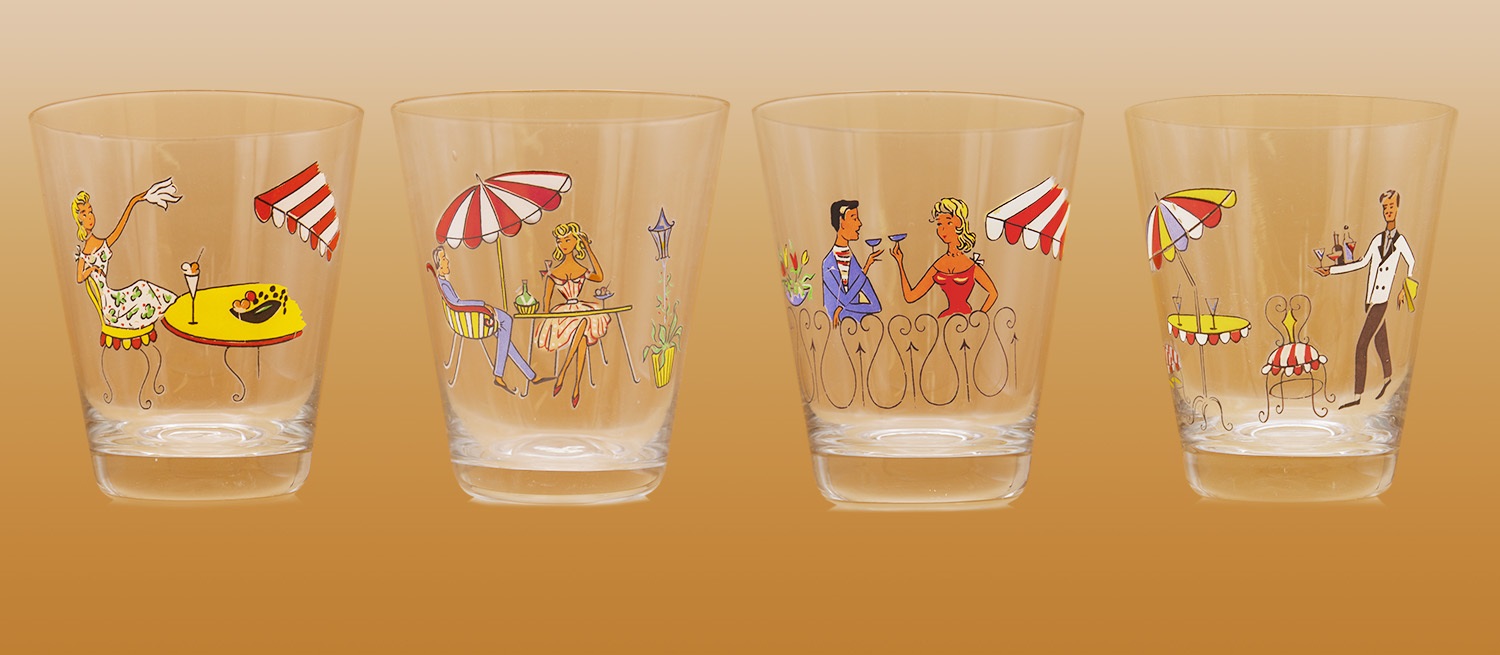
You can see relaxed guests - the women blonde, the men dark-haired - under colorful awnings and parasols. The dainty ice cream parlor furniture is unmistakable, with colourful sundaes and the classic wicker wine bottle for the Chianti. They are accompanied by a waiter who is as skillful as he is elegant and a couple toasting each other in love: "Cin cin!"
There's no doubt about it - in these glasses, plain water became aqua minerale and simple fizzy drinks became fruity lemonade. Perhaps this is the way to refresh the memory of an early Italian vacation or at least to bring a little ice cream parlor atmosphere home, preferably on the balcony or terrace.
The illustrator and the manufacturer of the glasses are unknown. However, the motifs refer to the boom in Italian ice cream parlors in the 1950s. The German economic miracle had made the first vacation trips to the south possible: After Austria, Italy was the most popular destination. Back in the north, the longing for Italy could be satisfied with short breaks in the ice cream parlor: People enjoyed gelato or cappuccino - and the accent of the waiters.
In addition, the modern ice cream parlors, like the milk bars, became venues for a developing youth culture. Unlike pubs, ice cream parlors were accessible to young people - and yet were not as staid as traditional confectionery cafés. In Wolfsburg, Silvio Olivier and his family established the first ice cream parlor in the Kaufhofpassage in 1953 - nine years before the first "guest workers" recruited in Italy came to work at the Volkswagen factory in the city.
Today, high-quality, artisan ice cream is as popular as ever. But some of the magic of the ice cream parlors, as conveyed by the drawings on the glasses, has been lost: Ice cream parlours are now just one of the countless facets of a globalized gastronomic offering.
Umbrella for the 29th International Summer Stage: Covered stage, logo and practical protection for changeable summer weather
1990s │ Inventory no. 008368 SMW
The International Summer Stage is being held for the 29th time this year. Although the stage and auditorium in the inner courtyard of Wolfsburg Castle are covered during the festival, an umbrella has already served well in local summers. The discreet advertising print on this one features a bright sun, which forms the "O" of the "Sommerbühne" lettering. However, the actual logo of the event deserves a closer look.
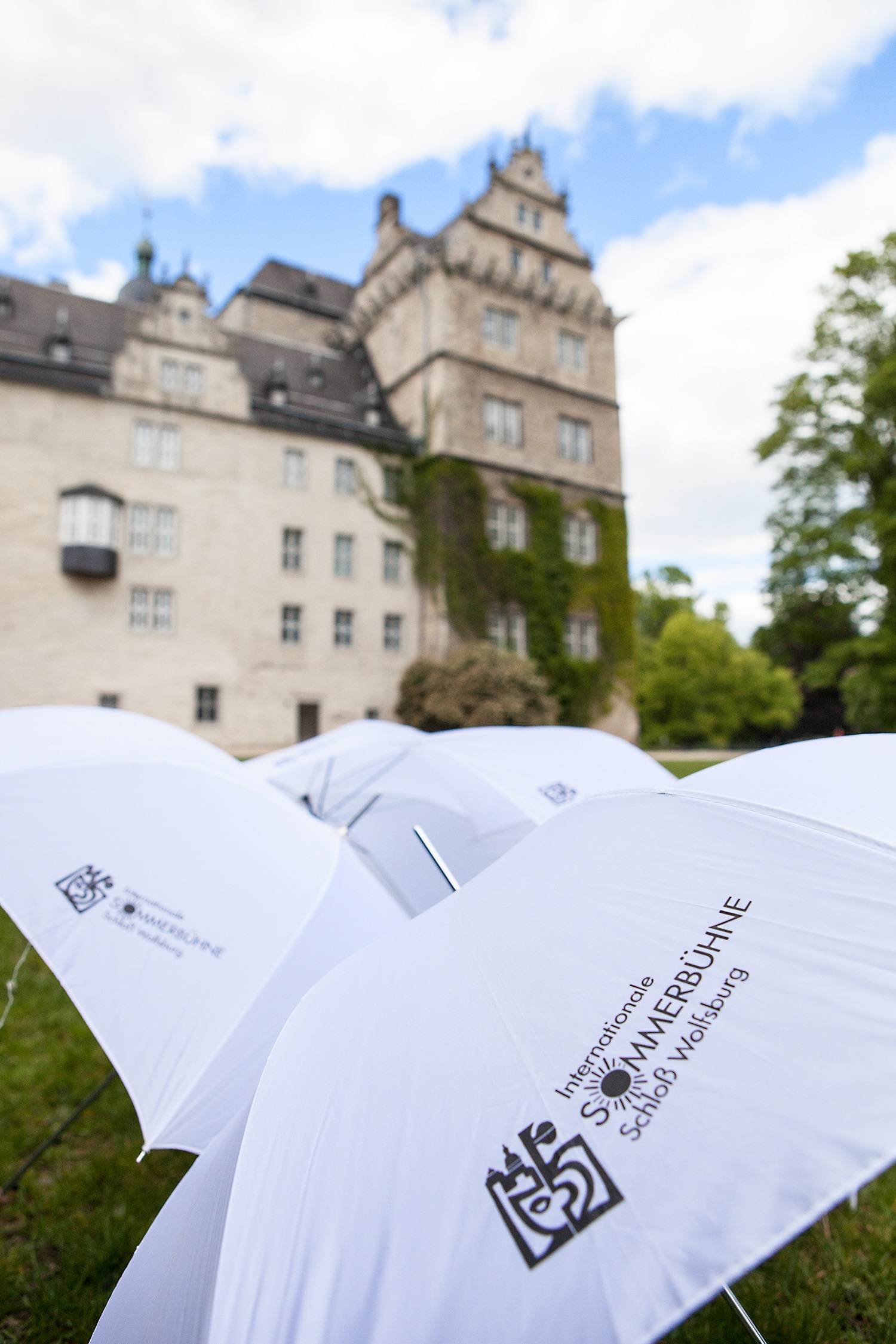
Its creator was the Polish-born graphic designer Gabriel Ryl. He designed the logo for the second edition of the festival in 1990/91, when it was called the International Summer Stage for the first time. The premiere - inspired by Wolfsburg's then Head of Cultural Affairs, Dr. Wolfgang Guthardt - had taken place in 1990. Back then, the title was "Grenzgänge - International Festival for Music, Theater, Voice and more". In the year after the fall of the Berlin Wall, overcoming borders was the dominant theme and a fitting motto.
Gabriel Ryl had studied graphic design at the Braunschweig University of Fine Arts and had not been working for the Wolfsburg advertising agency Cebra for long when his design was accepted by the cultural office. His summer stage logo shows all the elements that are important for the venue and the festival's offerings: The roof hood and gable are unmistakably from the castle, a mask stands for theater and cabaret and a guitar symbolizes the music programme. And can an ear perhaps be discovered in the body of the guitar?
With skilled craftsmanship, Ryl succeeded in giving the motif, which was created as a drawing and not yet executed on a computer, the rough appearance of a woodcut. Companions from the early years of the summer stage remember that he was very proud to be able to support this new event highlight in Wolfsburg's cultural life with his design. Even when the Summer Stage advertising was transferred to a larger agency in 1993, Ryl's logo was retained for many years. And it is still used today by the Friends of the International Summer Stage. With financial support and unsurpassed catering, the volunteers have been contributing to the success of the atmospheric summer festival at Wolfsburg Castle since 2000.
The TI-57 II: From school use at the Albert-Schweitzer-Gymnasium to the museum collection - A look at the evolution of the pocket calculator
1980s │ Inventory no. 004466 SMW
Pocket calculators were the first devices to bring the general public into contact with microelectronics.
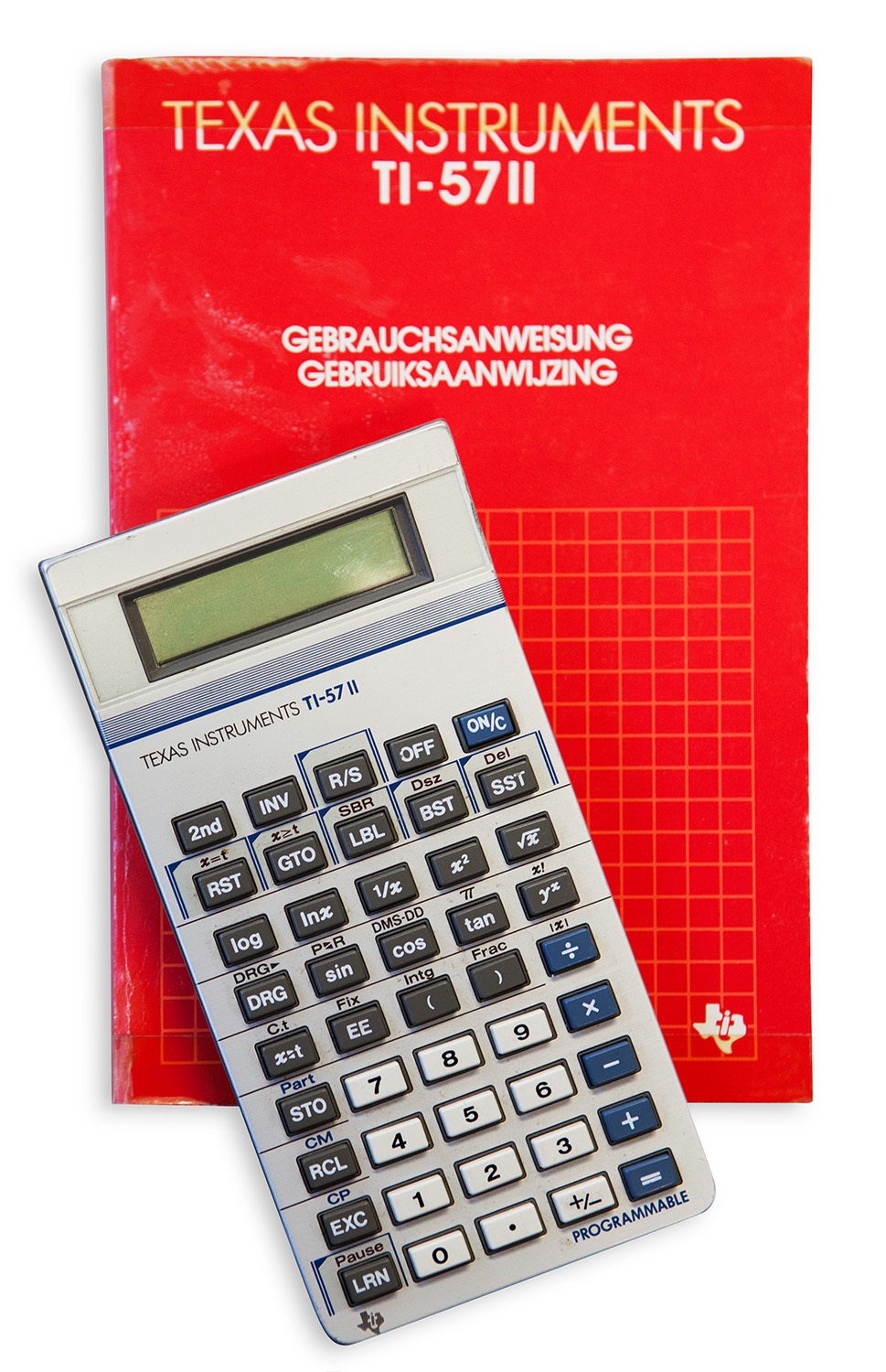
The TI-57 II model from Texas Instruments was used in the early 1980s by Christian Sochacki as a pupil at Wolfsburg's Albert-Schweitzer-Gymnasium. Over ten years ago, Mr. Sochacki gave the device to the museum collection.
The Heiligendorf native remembers that the range of functions of this programmable scientific and technical calculator was actually far too large for his basic mathematics course. However, the TI-30 school calculator he had previously used had a malfunction in the keyboard: this "quirk" often led to unintentional repeated entries, e.g. "222" instead of "2". Texas Instruments then took the calculators back and credited the price when buying a new TI calculator.
Since the early 1970s, pocket calculators have experienced a drop in price. Gradually, their use in school lessons was also permitted from this time onwards. The TI-30 mentioned above was the most widely used of the recommended models. It still had a rather clunky design, was powered by a 9-volt battery and had a display consisting of red
mini LEDs with magnifying glass elements. In contrast, the TI-57 II museum piece was much more modern with its flat housing, power supply from two button cells and an energy-saving liquid crystal display. Interested pupils at the Albert-Schweitzer-Gymnasium also studied the programming functions in a computer club.
The inventor of the pocket calculator was the physicist Jack Kilby, who worked at Texas Instruments: the prototype pocket calculator he presented in 1967 was still the size of an encyclopaedia volume. However, it promised an everyday application for the integrated circuit developed by Kilby. This combination of transistors, resistors and capacitors was the precursor to the microchip, the functional unit without which PCs, smartphones, the internet and many of the things we take for granted, such as cars, airplanes and televisions, would not exist in their current form.
Model railroads from the 1930s: highlight of the "Mechanical Animal World" special exhibition at the City Museum
around 1930 │ Inventory no. 007901 SMW
Depicting the big world in miniature is possible with numerous toys from the Stadtmuseum's collection. Like many of the animal figures in the special exhibition "Mechanical Animal World", which runs until mid-October 2019, the locomotive, carriages and tracks belong to the great age of tin toys.
The simple steam locomotive model, which was not based on a real locomotive, was part of a "starter set" from the Bing company. With a locomotive, coal tender, two wagons, an oval of track and a transformer, the model train game could begin. The transformer was used to regulate the speed and direction of travel and, above all, to convert the voltage of the mains supply to the 18 volts of the model railroad. Power was supplied to the locomotive by means of a sliding contact via the middle "conductor rail" of the three-rail track.
The small tin train runs on 0 gauge (32 mm), which corresponds to a scale of 1:45. This makes it about twice as large as the H0 model railroad size, which is the most widespread today ("half-zero", gauge 16 mm, scale 1:87).
The locomotive and carriages were manufactured by Bing-Werke AG from Nuremberg. Initially, the brothers Adolf and Ignaz Bing had founded a pure trading company, but from 1879 onwards the company produced tin toys itself. It developed the "Nuremberg style": industrial mass production by printing the sheet metal parts and joining them together using small tabs. The product range extended from steam engine models to doll dishes, from electric railroads of various gauges to narrow-gauge film projectors. At the beginning of the 20th century, Bing was the largest toy factory in the world with over 4,000 employees. The Great Depression led to the end of toy production in 1932.
The tin trains of the 1920s and 1930s were not yet manufactured to the perfection possible today. But this is precisely what gives them their very special charm. So it hardly matters that our museum pieces are no longer quite complete because they have suffered somewhat during play: The locomotive is missing the light bulb on the front and the original coupling, and the tender has even lost an axle...
A selection of brochures, leaflets and maps recalls the circumstances of traveling from the Federal Republic to the GDR and the opening of the inner-German border on November 9, 1989.
1965-1990 │ Various inventory numbers
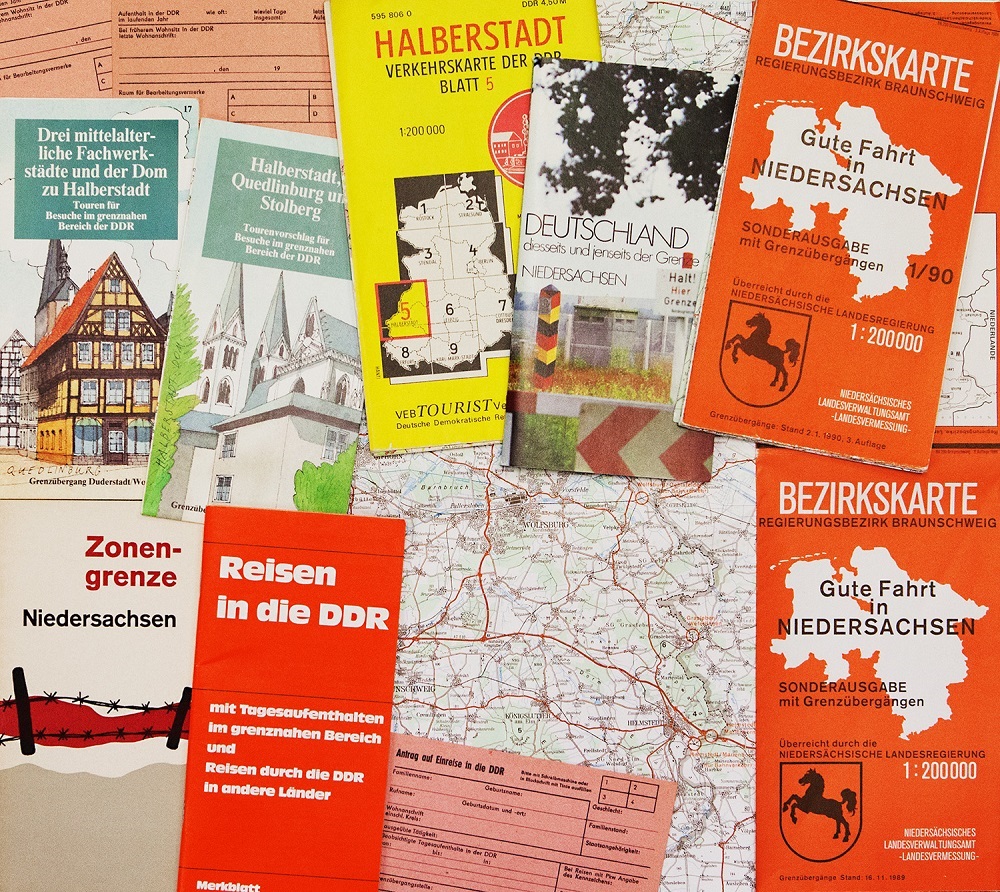
On October 24, 1989, Wolfsburg's German-German town twinning with Halberstadt was finally sealed with the approval of the town council there. At that time, the cities belonged to two states with different social systems. They were separated by a tightly secured border, which the GDR used to seal itself off and which was almost impermeable in an east-west direction. Travel from the Federal Republic to the GDR was possible, but required bureaucratic effort.
The state government of Lower Saxony, for example, produced numerous publications to provide information about the historical background of the border, the GDR's border security installations, border crossing points and lookout points. The appearance of these brochures changed, but even the covers made it clear that the "interface between the systems" was not a normal state border. For example, the cover of the booklet "Zonengrenze Niedersachsen" (Lower Saxony Zone Border) - published in 1965, four years after the Wall was built - shows an expressive barbed wire graphic. The brochure "Deutschland diesseits und jenseits der Grenze" from 1984 has a color cover photo with border posts, fences and a watchtower, which was taken from an apparently "safe distance" through a telephoto lens.
From 1973, the GDR allowed residents of towns and districts near the border in West Germany to take day trips to areas near the border. Wolfsburg and Halberstadt were also located in the regions where "small border traffic" - admittedly only from West to East - was possible. With the brochure "Traveling to the GDR", which was published several times, the Federal Ministry for Inner-German Relations provided information about the necessary travel documents, customs regulations and the minimum daily exchange rate of DM 25.00 for 25.00 GDR marks, as well as tips on how to behave and samples for filling out the entry forms. The ministry also wanted to encourage German citizens to take excursions near the GDR border with an attractively designed series of brochures: Several leaflets referred to the eastern Harz Mountains, and of course Halberstadt and its sights were also presented in detail.
The opening of the border on November 9, 1989 after the peaceful revolution in the GDR immediately led to an enormous amount of travel in an east-west direction. As a service provided by the state government, primarily for citizens of the GDR, road maps of the then still existing administrative districts of Lüneburg and Braunschweig were now published with the imprint "Gute Fahrt in Niedersachsen". They went through several updated editions in quick succession until the beginning of 1990, as new border crossings were constantly being added. Today, brown "information boards" on important roads across the state border commemorate the overcoming of the division of Germany and Europe.
idell series from Kaiser: The VW Beetle among work lights
Table lamp Kaiser idell 6556
before 1945 │ Inventory no. 003479 SMW
used in the office and workshop room of the former Wolfsburg local history museum in the Goethe School
Kaiser idell 6614 scissor wall lamp
around 1950 │ Inventory no. 006188 SMW
used in the former Fallersleben sugar factory
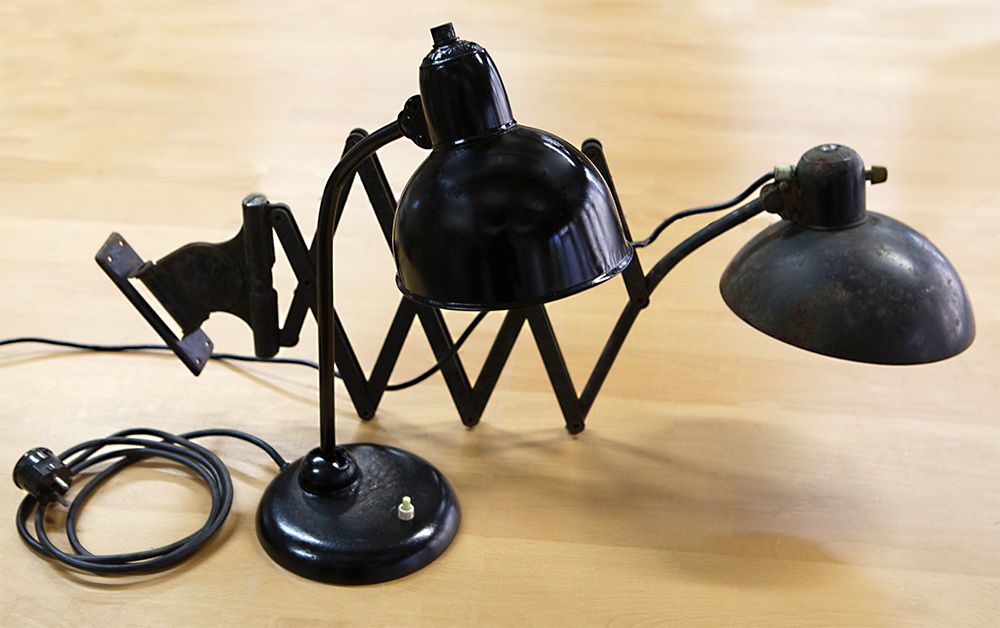
By Esther Orant, Forum Architektur der Stadt Wolfsburg
The luminaires in Kaiser's idell series, designed by Christian Dell, are something like the VW Beetle of task lights: widely used and well-known standard models with a high utility value that have been in production for decades.
In the 1920s, it was not only the Bauhaus, founded in Weimar in 1919, that advocated a functional, series-produced design for everyday objects. The Frankfurt art school also produced designs for inexpensive, functional series products as part of the building activities for the so-called "New Frankfurt". Christian Dell - dubbed the "lighting architect" in contemporary advertisements - taught in the metal workshops at both schools before designing his famous idell luminaires for the Kaiser company.
Christian Dell was born in Offenbach in 1893, the son of a master locksmith. From 1907 to 1911, he completed an apprenticeship as a silversmith in Hanau, where he also attended the state drawing academy. Before his military service in the First World War, he was an apprentice at Henry van de Velde's Grand Ducal Saxon School of Arts and Crafts in Weimar for a short time in 1912/13. In 1922, Walter Gropius hired the silversmith as a foreman at the metal workshop of the Bauhaus in Weimar, which was founded in 1919. As master craftsman, his main task was to provide technical and technical instruction to the students. His form masters were initially Paul Klee, Oskar Schlemmer, Johannes Itten and finally Lazlo Moholy-Nagy. Under the latter, the workshop turned increasingly towards industrial design.
When the Bauhaus moved to Dessau in 1925, Dell initially remained in Weimar and worked at the successor institution there, the "Hochschule für Handwerk und Baukunst". In 1926, Dell took over the management of the metal workshop at the Frankfurt art school. It was during this time that Christian Dell produced his first successful lamp designs. He was dismissed by the National Socialists in 1933.
From 1933/34, Dell worked as a designer for the lighting manufacturer Gebrüder Kaiser & Co. in Neheim-Hüsten. He developed the well-known Kaiser-idell luminaires for the company. The name "idell" is made up of the words "idea" and "Dell". Christian Dell had already integrated his surname into the product names of his earlier designs ("Rondella"). The models in the idell series were produced until the 1980s. In his design work for Kaiser, Dell consistently implemented the requirements formulated by the Bauhaus and the "New Frankfurt": design reduced to functionality and inexpensive industrial production through a modular system that could be combined in many ways.
Certainly the best-known model in the series is the "6556" desk lamp, which was developed in 1934, first listed in the sales catalog in 1935 and produced until the 1950s. A characteristic feature of the idell lamps is the ball joint between the lamp arm and reflector shade, which allows the light cone to be flexibly aligned. The special shape of the reflector shade also contributes to the high functional quality of idell luminaires: The decentralized arrangement of the so-called dome, which holds the socket for the light source, means that the brightest point of the light cone is not centrally located under the shade, but offset to the front, avoiding distracting shadows, for example caused by a writing hand. The lower edge of the shade, which is also asymmetrical, ensures that the light bulb is shielded from the eye, preventing unwanted glare.
After the war, Dell worked as a self-employed jeweler and silversmith in Wiesbaden, where he died in 1974.
Christmas rocking horses: Handmade joy from Nordsteimke
1920s │ Inventory number 004446 SMW
and toy tractor
1940s │ Inventory number 004452 SMW
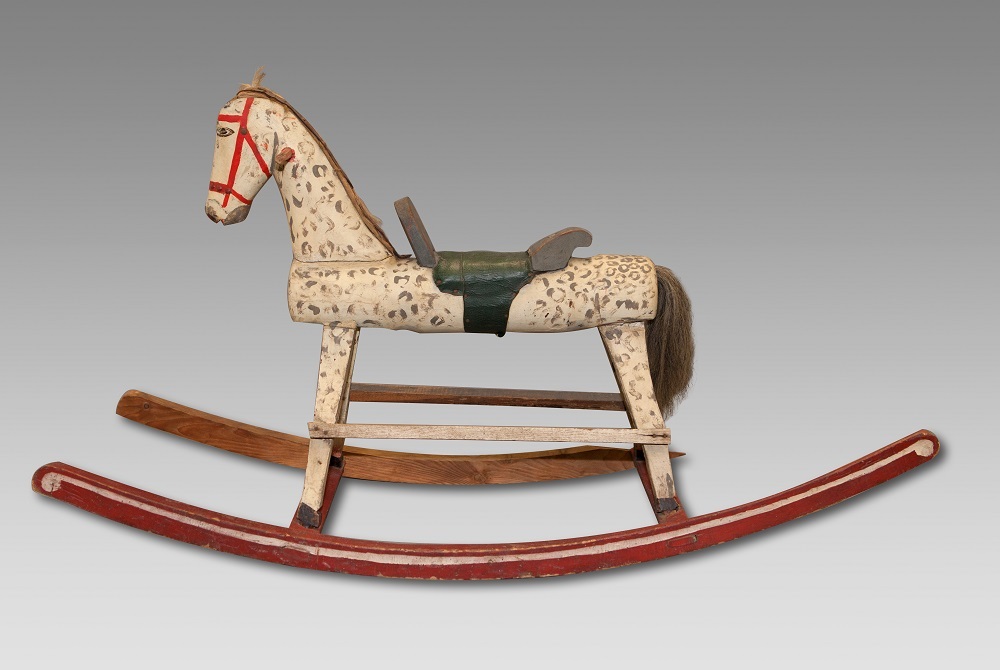
Rocking horses are popular ornamental and decorative motifs at Christmas time. They symbolize children's play and the joy of receiving presents. This example was built in a workshop in Nordsteimke and was given as a Christmas present twice in the course of its eventful toy life.
At the end of the 1920s, the farmer and wheelwright Hermann Mahlmann made the present museum piece as a Christmas present for his son Gerhard. His younger brother Siegfried Mahlmann - known today for his commitment to the dance and traditional costume group "De Steinbekers" and the Low German theater - remembers wild rides and worried parents. His brother actually fell headfirst once, whereupon his father put a brake on the runners. The rocking horse was only taken out of the attic on festive days and holidays. According to Siegfried Mahlmann, he himself rarely rocked on the horse. This was because the first tractors were purchased in the villages in the 1930s - and these were now much more interesting to him than horses, and a tractor model was much more appealing than a horse toy.
But the rocking horse had another big appearance: when refugees were billeted with the Mahlmanns after the Second World War, it was given to a family as a Christmas present for their son. The two fathers refurbished the already somewhat worn horse, repaired a runner and gave it a new coat of paint: the original bay horse became today's apple gray.
Wheelwright Hermann Mahlmann, in whose workshop for wheels, carts and agricultural equipment the rocking horse had once been made, had long since responded to the wishes of the boys from the village and devised a simple but attractive tractor model. Siegfried Mahlmann recalls that he once saw six or seven of them lined up on one of his father's workbenches, all ordered as gifts for farmers' sons. The mechanization of agriculture is also reflected in the toys from a wooden workshop in Nordsteimke.
